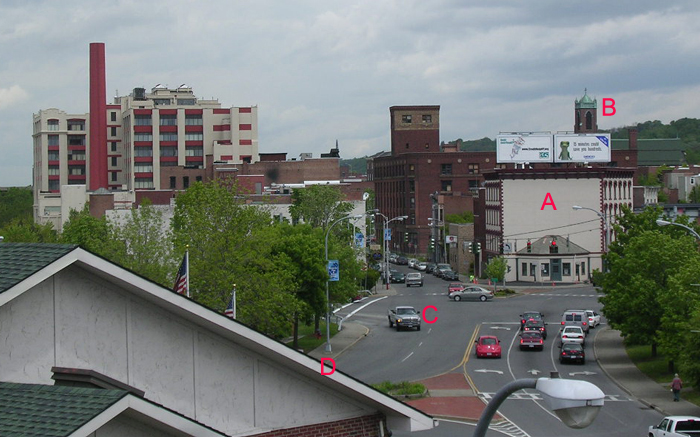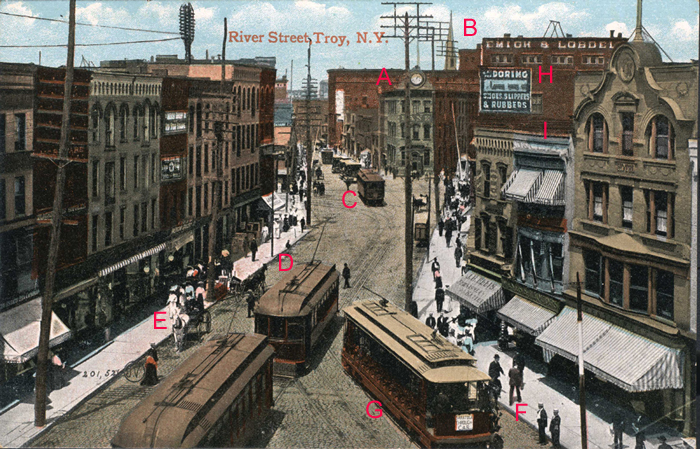|
100 Years in ROLLING DOWN If the Valentine Postcard Company is to be believed, a hundred years ago Troy's River Street mixed earthtone buildings, ladies in ankle-length dresses of searing white and vivid pastels, and men in funereal-looking suits. When the Manufacturers Bank clock showed a few minutes past one (A), the merchants on the west side of River were furling their fashionably-striped awnings as their competitors across the street unrolled theirs. A steady parade of streetcars rolled past wagon teams and a sporty sulky pulled by a white horse (E). The afternoon was warm enough for some men to substitute straw boaters for derbies (F) and for the "Through Car To Saratoga" (G) to open its sides. Near the corner of Federal Street (C), a sidewalk sale was in progress. |
From the 1880s, the cuff and collar factory of Mott Emigh and Pierson Lobdel stood at at 3 King Street (B), while Robert A. Doring sold shoes, slippers, and rubbers at 182 River (H). J.H. Ellis' haberdashery and hat store stood beside the liquor store of J.C. McCauley and Michael H. Keating, Sixth Ward alderman, at 172 River (I). |
| One hundred years later the cobblestones, trolleys, and pedestrians have disappeared, and shade trees substitute for the telephone poles that once stood as tall as ships' masts. A silver pickup traces the vanished tracks that carried trolleys to downtown Troy from the Green Island Bridge (C).
The Manufacturers Bank and its cornice clock (A) are gone, although the room where the agreement to finance the construction of the USS Monitor was signed was moved to what is now the Franklin Plaza reception hall. St. Peter's Catholic Church at 4th and Hutton Streets (B) appears to have been re-steepled. However, the most notable difference is the subtraction of the colorful and fancifully-styled storefronts, each of which seemed a testimonial to the individual taste of its builder and a symbol of the business which it housed. Many classic storefronts survived into the 1970s, when Troy, which had lost over 25% of its population in 30 years, underwent much urban renewal. What's left is a more spacious but vastly less interesting streetscape. PHOTO AND FIELD INVESTIGATION BY HOWARD OHLHOUS |
 The red and white building with the red brick smokestack once housed the Cluett, Peabody & Company, Inc., makers of Arrow shirts and collars. Shortly after World War I, inventor Sanford L. Cluett, a nephew of the company owner, determined that shrinkage occurred because shirt fabric which had become stretched in the manufacturing process returned to its normal size after washing. In the 1920s, he developed the "compressive shrinkage process" which became known as "Sanforizing" after its inventor. Cluett, Peabody then licensed the process to the entire textile industry. After the company left Troy in the late 1980s, its factory was transformed into the Headley Park Place office complex.T Today the wagon unloading goods in the postcard view (D) would be partially screened by the Franklin Square Hotel, which stands beside the Troy Atrium parking garage from which the photo was taken. Click here to return to the "Lost Landmarks of Upstate New York" homepage. |
